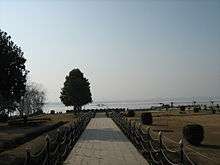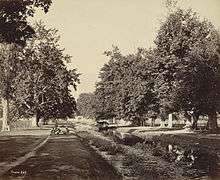Shalimar Bagh, Srinagar
| Shalimar Bagh | |
|---|---|
|
शालीमार बाग़ شالیمار باغ | |
|
The Shalimar Bagh pavilions in the periphery of Dal Lake | |
| Type | Mughal garden |
| Location | Srinagar, Kashmir |
| Coordinates | 34°8′32.48″N 74°51′46.48″E / 34.1423556°N 74.8629111°ECoordinates: 34°8′32.48″N 74°51′46.48″E / 34.1423556°N 74.8629111°E |
| Area | 12.4 hectares (31 acres) |
| Opened | 1619 A.D. |
| Founder | Jahangir |
| Owned by | Jammu and Kashmir Tourism Department |
| Operated by | Jammu and Kashmir Tourism Department |
| Website |
www |
Shalimar Bagh (Hindi: शालीमार बाग़; Urdu: شالیمار باغ) is a Mughal garden in Srinagar, linked through a channel to the northeast of Dal Lake, on its right bank located on the outskirts of Srinagar city in Jammu and Kashmir. Its other names are Shalimar Garden, Shalimar Bagh, Farah Baksh and Faiz Baksh, and the other famous shore line garden in the vicinity is Nishat Bagh. The Bagh was built by Mughal Emperor Jahangir for his wife Noor Jahan, in 1619. The Bagh is considered the high point of Mughal horticulture. It is now a public park. This time it's also called as crown of Srinagar [1][2]
History

While the recent history and development of the Mughal types of gardens is credited to Emperor Jahangir, the ancient history of the garden can be traced to the 2nd century when it was built during the reign of Pravarsena II. Praversena II founded the city of Srinagar and ruled in Kashmir from 79 AD to 139 AD. He had built a cottage for his stay at the northeastern corner of the Dal Lake and had named it Shalimar . The word "Shalimar " in Sanskrit means abode of love. The king, on his visits to a local saint by the name Sukarma Swami at Harwan, used to stop at this cottage. Over the years, the cottage fell into ruins and later could not be located. However, the name of the village remained as Shalimar.
It is here that Emperor Jahangir built his celebrated Shalimar Bagh, his dream project to please his queen.[3] He enlarged the ancient garden in 1619 into a royal garden and called it 'Farah Baksh' ('the delightful'). He built it for his wife Nur Jahan ('light of the world'). In 1630, under Emperor Shah Jahan’s orders, Zafar Khan the governor of Kashmir extended it. He named it ‘Faiz Baksh’ ('the bountiful'). It then became a pleasure place for the Pathan and Sikh governors who followed Zafar Khan.
During the rule of Maharaja Ranjit Singh the marble pavilion was the guest house for European visitors. Electrification of the premises was done during Maharaja Hari Singh’s rule. Thus, over the years, the garden was extended and improved by many rulers and called by different names, but the most popular name ‘Shalimar Bagh’ continues to this day.[2][4]
During the Mughal period in particular, Emperor Jahangir and his wife Nur Jahan were so enamoured of Kashmir that during summer they moved to Srinagar with their full court entourage from Delhi at least 13 times. Shalimar Bagh was their imperial summer residence and the Royal Court. They crossed the arduous snowy passes of the Pir Panjal mountain range on elephants to reach Srinagar.[5]
Layout

The layout of the garden is an adaptation of another Islamic garden layout known as the Persian gardens. This garden built on a flat land on a square plan with four radiating arms from a central location as the water source. It needed to be modified to suit the hilly terrain and availability of a well, which could be diverted from a higher elevation to the planned gardens. Modifications involved the main channel running through the garden axially from top to the lowest point. This central channel, known as the Shah Nahar, is the main axis of the garden. It runs through three terraces. This layout left out the radial arms and the shape became rectangular, instead of a square plan of the Chahar Bagh.[2]
The garden, as finally laid out, covers an area of 12.4 hectares (31 acres) built with a size of 587 metres (1,926 ft) length on the main axis channel and with a total width of 251 metres (823 ft). The garden has three terraces fitted with fountains and with chinar (sycamore) tree-lined vistas. The Shahnahar is the main feeder channel to all the terraces. Each one of the three terraces has a specific role.[2]
The garden was linked to the open Dal Lake water through a canal of about 1 mile (1.6 km) length and 12 yards (11 m) in width that ran through swampy quagmire. Willow groves and rice terraces fringed the lake edge. Broad green paths bordered the lake with rows of chinar trees. The garden was laid in trellised walkways lined by avenues of aspen trees planted at 2 feet (0.61 m) interval.[3]
Architecture


The architectural details of the three terraces of the garden are elaborate.
The first terrace is a public garden or the outer garden ending in the Diwan-e-Aam (public audience hall). In this hall, a small black marble throne was installed over the waterfall.[2][5]
The second terrace garden along the axial canal, slightly broader, has two shallow terraces. The Diwan-e-Khas (the Hall of Private Audience), which was accessible only to the noblemen or guests of the court, now derelict, is in its centre. However, the carved stone bases and a fine platform surrounded by fountains are still seen. The royal bathrooms are located on the north-west boundary of this enclosure. The fountain pools of the Diwan-e-Khas, the Diwan-e-Aam, and in turn, the Zenana terrace ae supplied in succession.[6] it has 410 fountains
In the third terrace, the axial water channel flows through the Zenana garden, which is flanked by the Diwan-e-Khas and chinar trees. At the entrance to this terrace, there are two small pavilions or guard rooms (built in Kashmir style on stone plinth) that is the restricted and controlled entry zone of the royal harem. Shahajahan built a baradari of black marble, called the Black Pavilion in the zenana garden. It is encircled by a fountain pool that receives its supply from a higher terrace. A double cascade falls against a low wall carved with small niches (chini khanas), behind the pavilion. Two smaller, secondary water canals lead from the Black Pavilion to a small baradari. Above the third level, two octagonal pavilions define the end wall of the garden. The baradari has a lovely backdrop of the snow mountains, which is considered a befitting setting for the Bagh.[2][6]
The Shalimar Bagh is well known for chini khanas, or arched niches, behind garden waterfalls. They are a unique feature in the Bagh. These niches were lighted at night with oil lamps, which gave a fairy tale appearance to the water falls. However, now the niches hold pots of flower pots that reflect their colours behind the cascading water.[2][6]
Another unusual architectural feature mentioned is about the doors of the Baradari. In the garden complex, the Baradari had four exquisite doors made of stones supported by pillars. It is conjectured that these stone doors were ruins from old temples that were demolished by Shahajahan. The garden also provided large water troughs where a variety of fountains were fixed.[7]
It has been aptly described by a chronicler glowingly:
| “ | A subtle air of leisure and repose, a romantic indefinable spell, pervades the royal Shalimar: this leafy garden of dim vistas, shallow terraces, smooth sheets of falling water, and wide canals, with calm reflections broken only by the stepping stones across the streams. | ” |
Even in later years, during Maharaja’s rule, the gardens were well maintained and continue to be so even now as it is one of the prominent visitor attractions around the Dal Lake.
The garden is considered to be very beautiful during the autumn and spring seasons due to the colour change in leaves of the famed Chinar trees.
The gardens were the inspiration for other gardens of the same name, notably the Shalimar Bagh, Delhi in Delhi (built in 1653, which now also has an upscale colony) and Shalimar Gardens in Lahore, Pakistan built by Emperor Shah Jahan in 1641.
The black pavilion built during the early part of Jahangir's reign (1569–1627), in the top terrace of the Shalimar Bagh, has the famous inscription in Persian, which says:[8][9]
Agar Firdaus bar rōy-e zamin ast, hamin ast-o hamin ast-o hamin ast.
This is a couplet by the Persian-language poet Amir Khusrau, which is inscribed on many other buildings also in India and Pakistan.
Translated to English, it means:
| “ | If there is a paradise on earth, it is here, it is here, it is here. | ” |
It is also mentioned that when Jahangir was asked on his death bed about his cherished desire he is credited to have said:[10]
| “ | Kashmir, the rest is worthless. | ” |
See also
References
- ↑ Bindloss, Joe; Sarina Singh (2007). India. Srinagar. Lonely Planet. pp. 353–354, 360. ISBN 1-74104-308-5. Retrieved 2009-12-29.
- 1 2 3 4 5 6 7 "Shalimar Gardens in Srinagar". Archnet.org. Retrieved 2009-12-25.
- 1 2 Stuart, C.M. Villiers (2008). Gardens of the Great Mughals (1913). Gardens of Dal Lake. Read Books. pp. 162–166. ISBN 1-4097-1962-6. Retrieved 2009-12-30.
- ↑ "Shalimar Bagh Mughal Garden, Srinagar". Retrieved 2009-12-30.
- 1 2 "The Royal Gardners of Mughal India". Retrieved 2009-12-30.
- 1 2 3 "History of Shalimar Bagh". 2009-04-04. Retrieved 2009-12-30.
- 1 2 Stuart p.167
- ↑ Sajjad Kausar (July 2005). "Meaning of Mughal Landscape" (pdf). p. 1. Retrieved 2009-12-31.
- ↑ Blake, Stephen P. (2002). Shahjahanabad: The Sovereign City in Mughal India (1639-1739). Cambridge University Press. p. 44. ISBN 0-521-52299-4. Retrieved 2009-12-31.
- ↑ Byline. Chronicle Books. 2003. p. 248. ISBN 81-8028-003-9. Retrieved 2009-12-31.
External links
| Wikimedia Commons has media related to Shalimar Bagh (Srinagar). |